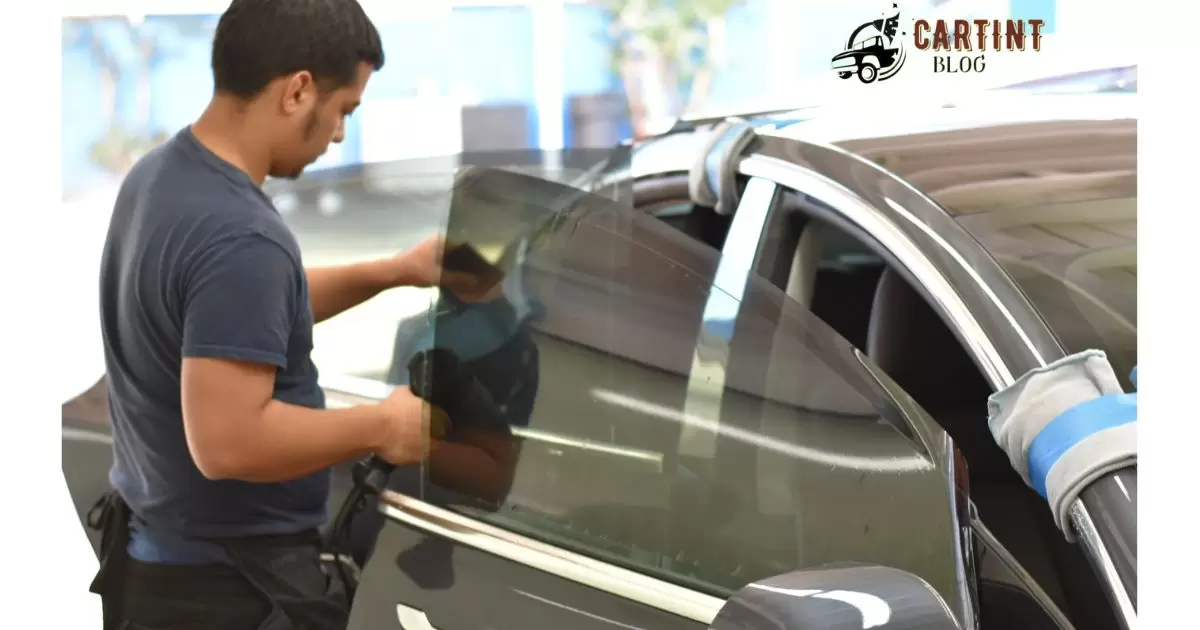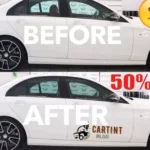Ceramic window tint is applied by infusing ceramic particles into the film, as opposed to conventional tint, which employs dyes. These nano-ceramic particles are essential for rejecting a significant amount of solar heat and shielding damaging UV rays. The ceramic composition distinguishes this tint from traditional options, offering improved durability and heat rejection.
What is Ceramic Window Tint for Cars? A cutting-edge solution for automotive window tinting, this innovative film utilizes advanced ceramic technology. Say goodbye to the discomfort of excessive heat and glare in your car while enjoying a sleek and modern aesthetic.
Ceramic Window Tint for Cars is designed to offer more than just enhanced aesthetics. With exceptional heat reduction capabilities, it helps keep the car’s interior cool and protects occupants from harmful UV rays. This tint also minimizes glare, ensuring a safer and more comfortable driving experience.
What Is A Ceramic Window Tint?
The most expensive film available is ceramic window tint, which is well-known for its ability to reject extreme heat, especially in Texas. It makes use of the same kind of sheets as ordinary window film, but the coating contains ceramic particles.
Ceramic window tint for cars is a high-performance window film that uses ceramic particles to block heat and UV rays. It provides superior heat rejection compared to traditional tint films. The ceramic composition ensures optimal visibility and reduces glare for a comfortable driving experience.
How Is Ceramic Tint For Windows Made?
A premium polyester film and ceramic particles are combined to create ceramic tint. The film’s distinct ability to repel heat is derived from the incorporation of ceramic particles. As a result, the tint offers excellent sun protection without compromising signal quality or visibility.
Once the ceramic particles are layered between the film and the adhesive, creating a barrier that reflects and absorbs the harmful rays from the sun, the interior of the car becomes cooler and less UV radiation can enter the vehicle because the ceramic particles are made of inorganic materials that block UV rays and infrared heat.
What Are The Benefits Of A Ceramic Window Film?
Ceramic window films for cars offer numerous benefits. Firstly, they provide exceptional heat rejection, blocking a significant amount of solar heat to keep the car’s interior cool. This results in improved comfort during hot weather, reducing the need for excessive air conditioning and enhancing fuel efficiency.
Heat Rejection
Ceramic window films for cars provide exceptional heat rejection, ensuring a cooler interior even in scorching conditions. With a high infrared rejection rate, these films efficiently block out heat, maintaining a comfortable driving environment.
UV Ray Protection
One of the key benefits of ceramic window films is their superior UV ray protection. They block up to 99% of harmful UV rays, safeguarding both passengers and the car’s interior from the damaging effects of prolonged sun exposure. This protection helps prevent fading of upholstery and reduces the risk of skin damage.
Glare Reduction
Ceramic window films effectively reduce glare, improving visibility and safety on the road. By minimizing the impact of harsh sunlight and headlights from other vehicles, these films contribute to a more comfortable and secure driving experience.
Is Ceramic Tint Worth The Money?
Ceramic tint is a valuable investment for several reasons. Firstly, it provides superior heat rejection compared to traditional films, blocking up to 99% of harmful UV rays. This helps maintain a comfortable interior temperature and reduces the workload on your vehicle’s air conditioning, ultimately improving fuel efficiency.
Ceramic tint is significantly superior in terms of longevity and robustness. Even though ceramic tint may cost more initially, its increased performance and longevity might save the need for frequent replacements, saving you money over time.
Ceramic Tint Vs Regular Tint
Ceramic tints, like ceramic window tint, offer 99% UV protection and up to 85% heat reduction.
Although regular or classic tinting is less expensive, it only provides a minimal level of sun protection and lets UV rays into the automobile.
Ceramic tint and regular tint differ in composition and performance. Ceramic tint is made from ceramic particles that block more heat and UV rays compared to regular tint, which typically contains metalized layers.
This results in ceramic tint being more effective in heat reduction and UV protection. Additionally, ceramic tint doesn’t interfere with electronic signals, making it suitable for vehicles with advanced technology systems.
Here’s a detailed table comparing Ceramic Tint and Regular Tint based on the information provided.
| Feature | Ceramic Tint | Regular Tint |
| Composition | Made from ceramic particles | Typically contains metalized layers |
| Heat Rejection | More effective in reducing heat | Provides moderate heat reduction |
| UV Protection | Blocks more UV rays | Offers standard UV protection |
| Signal Interference | Does not interfere with electronic signals | May interfere with electronic systems |
| Cost | Generally more expensive | More affordable |
| Technology Compatibility | Suitable for advanced technology systems | May impact electronic systems in some vehicles |
| Transparency | Maintains clarity and visibility | Provides good visibility with slight tinting |
Heat Resistance
Ceramic tint for cars enhances heat resistance by blocking a significant amount of infrared radiation. This results in a cooler interior, reducing the need for excessive air conditioning. Studies show that ceramic tint can block up to 99% of harmful UV rays, protecting both passengers and the car’s interior from sun damage.
Furthermore, this advanced tinting technology provides enhanced privacy without compromising visibility. Unlike traditional tints, ceramic tint does not interfere with electronic signals, ensuring seamless use of GPS, mobile devices, and other communication tools.
Clarity and Visibility
Ceramic tint enhances clarity and visibility in cars. It provides optimal UV protection, reducing glare and safeguarding the interior from sun damage. With advanced technology, ceramic tint ensures a clear view without compromising safety.
This tint is professionally engineered for maximum heat rejection, keeping the interior cool and comfortable. It boasts impressive infrared and heat-blocking capabilities, maintaining a sleek appearance while delivering exceptional performance. Choose ceramic tint for cars to enjoy superior clarity, visibility, and a professional touch to your vehicle.
Durability
Ceramic tint enhances car durability. It blocks up to 99% of harmful UV rays, preventing interior fading and cracking. Additionally, it reduces heat absorption, preserving the vehicle’s overall condition.
Focused on performance, ceramic tint ensures optimal visibility and safety. It provides up to 60% heat rejection, promoting a comfortable driving experience. Moreover, ceramic tint enhances privacy while complying with legal regulations.
Is Ceramic Tint Legal
Ceramic tint for cars is legal in many states, meeting regulations for acceptable light transmission levels. The tint’s composition often includes nanoparticles that effectively block UV rays without impairing visibility. Across the United States, specific laws dictate the allowable darkness levels for car window tints, and ceramic tint generally complies with these standards.
When considering ceramic tint, it’s important to note that its popularity stems from superior heat rejection capabilities compared to traditional films. On average, ceramic tint can block up to 50-70% of solar heat, enhancing comfort within the vehicle while providing an added layer of UV protection.
Top 10 States Where Ceramic Tint Is Legal
In the United States, ceramic tint for cars is legal in several states, making it a popular choice for vehicle owners seeking enhanced privacy and heat protection. Among the top 10 states where ceramic tint is permitted, Texas stands out, allowing up to 25% visible light transmission on front side windows.
California follows closely, permitting ceramic tint with a minimum of 70% VLT on the front side windows. Other states such as Florida, Arizona, and Georgia also allow ceramic tint, each with specific regulations regarding visible light transmission percentages.
- California
Ceramic tint is legal, with regulations specifying acceptable light transmission levels for front and rear windows.
- Texas
Permissible use of ceramic tint is governed by state laws, ensuring compliance with light transmission standards.
- Florida
Ceramic tint is allowed, offering car owners the benefits of enhanced heat rejection and UV protection.
- New York
Regulations permit the use of ceramic tint, provided it adheres to specified darkness limits for window films.
- Illinois
Car owners can legally install ceramic tint, which is valued for its heat-blocking properties and UV-ray reduction.
- Georgia
Ceramic tint is recognized as a legal option, contributing to improved comfort and sun protection within vehicles.
- Ohio
State regulations allow for the use of ceramic tint, striking a balance between visibility and solar heat rejection.
- Arizona
Ceramic tint is a popular choice, meeting state guidelines for window tint darkness to ensure legal use.
- North Carolina
Car owners can benefit from ceramic tint, complying with state laws governing allowable window darkness.
- Michigan
Legal use of ceramic tint is defined by state regulations, offering residents the advantages of improved heat rejection and UV blocking.
Is Ceramic Tint Better Than Regular Tint?
Firstly, ceramic tint is superior to other materials in terms of heat rejection and UV protection. Its cutting-edge design helps to reject a substantial amount of solar heat and block approximately 99% of dangerous UV rays, keeping your vehicle cooler and shielding the inside from sun damage. Conversely, regular tint falls short of ceramic tint’s efficacy, even though it still provides some heat reduction and UV protection.
Second, there is a clear difference in the degree of infrared shielding provided by these two kinds of tints. Because ceramic tint contains nano-ceramic particles, it has more infrared rejection capabilities than regular tint, which further reduces interior vehicle heat. Regular tint does not have any infrared rejection features.
What Is The Benefit Of Ceramic Tint?
Ceramic tint for cars offers numerous benefits. Firstly, it provides exceptional heat rejection, blocking up to 99% of harmful UV rays. This results in a cooler interior, reducing the need for excessive air conditioning and promoting fuel efficiency. Ceramic tint enhances privacy by reducing visibility into the vehicle while maintaining optimal clarity from inside.
Benefits of Ceramic Tint for Cars:
- Exceptional Heat Rejection
- Blocks up to 99% of harmful UV rays.
- Keeps the car interior significantly cooler.
- Reduces reliance on air conditioning, promoting fuel efficiency.
- Enhanced Privacy
- Reduces visibility into the vehicle.
- Maintains optimal clarity from inside.
- Superior Durability
- Resists scratches and fading over time.
- Ensures a long-lasting and attractive tint.
- Non-Interference with Electronics
- Advanced technology prevents interference with GPS and mobile devices.
- Maintains the functionality of electronic systems in the car.
Ceramic tint emerges as a valuable investment, offering a combination of comfort, privacy, durability, and electronic functionality for car owners.
Which Tint Is Better Carbon Or Ceramic?
Carbon tint and ceramic tint are both popular choices for car windows. Carbon tint provides a sleek appearance and effectively blocks UV rays. On the other hand, ceramic tint excels in heat rejection, offering superior protection against solar heat. When choosing between them, consider your priorities whether it’s style or enhanced thermal performance.
For precise data, carbon tint typically blocks around 40-50% of solar heat, while ceramic tint can block up to 50-70%. In terms of UV rejection, both options surpass 99%.
It’s up to you to decide how to respond to this question. It goes without saying that ceramic window tints are higher-quality and more durable than carbon window tints. Sun fading and solar heat are prevented by both carbon and ceramic tints. Ceramic window tint will be useful, nonetheless, if you require even greater protection, security, and anti-shattering qualities.
Here’s a detailed table summarizing the information.
| Feature | Carbon Tint | Ceramic Tint |
| Appearance | Provides a sleek appearance | Offers a high-quality look |
| UV Blocking | Effectively blocks UV rays | Surpasses 99% UV rejection |
| Heat Rejection | Blocks around 40-50% of solar heat | Blocks up to 50-70% of solar heat |
| Thermal Performance | Good for style; consider priorities | Excels in heat rejection |
| Price | Generally more affordable | Typically more expensive |
| Durability | Less durable compared to ceramic | Higher quality and more durable |
| Additional Qualities | – | Offers enhanced protection, security, and anti-shattering properties |
| Overall Consideration | Consider priorities – style or performance | Optimal for those seeking superior protection |
Please note that the table is based on the provided information and aims to present a concise overview of the key features and differences between carbon and ceramic tints for car windows.
How Long Does Ceramic Window Tint Last?
A ceramic auto window tint can last five years with the right auto care. Ten years is the average lifespan of metallic car window tinting when installed and maintained properly. This durability is due to the advanced technology in ceramic films, providing superior heat resistance, UV protection, and color stability.
When considering the longevity of ceramic window tint, it’s crucial to note that the actual duration can vary based on factors such as climate, driving conditions, and installation quality. In regions with harsh sunlight or extreme temperatures, the tint may experience a slightly shorter lifespan.
FAQs
How long does ceramic window tint last on car windows?
Ceramic window tint for cars can last up to 10 years or more, depending on factors like climate and proper maintenance.
What makes ceramic window tint different from other options?
Ceramic tint stands out for its advanced technology, offering superior heat resistance, UV protection, and color stability compared to traditional tinting options.
Is ceramic window tint a cost-effective choice?
While ceramic tint may have a higher upfront cost, its long lifespan and enhanced performance make it a cost-effective investment in the long run.
Does ceramic window tint affect visibility during nighttime driving?
Ceramic tint is designed to maintain visibility at night, ensuring that it enhances comfort without compromising safety on the road.
Can ceramic window tint be applied to any car model?
Yes, ceramic window tint is versatile and can be applied to various car models, providing enhanced benefits across different vehicle types.
Conclusion
To sum up, ceramic tint for cars emerges as a top-notch choice for drivers seeking long-lasting benefits. With an impressive lifespan of around 10 years or more, this tinting option offers durability, superior heat resistance, and reliable UV protection. It stands resilient against various climates and driving conditions, providing both aesthetic appeal and functional advantages.
So, when opting for ceramic tint, you’re not just enhancing the style of your vehicle; you’re making a lasting investment in comfort and protection that extends well into the future. Upgrade your car with ceramic tint for a driving experience that combines longevity and performance.



